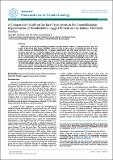Por favor, use este identificador para citar o enlazar a este item:
http://hdl.handle.net/10261/150124COMPARTIR / EXPORTAR:
 SHARE SHARE
 CORE
BASE CORE
BASE
|
|
| Visualizar otros formatos: MARC | Dublin Core | RDF | ORE | MODS | METS | DIDL | DATACITE | |

| Título: | A Comparative Study on Surface Treatments in the Immobilization Improvement of Hexahistidine-tagged Protein on the Indium Tin Oxide Surface |
Autor: | Ismail, M.B.; Casañ Pastor, Nieves CSIC ORCID; Pérez Soler, Estela CSIC; Soltani, A; Othmane, A | Palabras clave: | Indium tin oxide Piranha treatment Biofunctionalization AFM XPS Histidine-tagged proteins Electrochemistry Indium tin oxide |
Fecha de publicación: | ene-2016 | Editor: | OMICS Publishing Group | Citación: | Journal of Nanomedicine & Nanotechnology 07(02): 1000372 (2016) | Resumen: | Biosensors are becoming increasingly important in various sectors. However, choosing transducer type and surface treatment still faces severe limitations. Indium-tin oxide is widely used in electrochemical sensing, though surface cleaning and functionalization are not always straightforward and often poorly controlled. Here, we have covalently immobilized a hexahistidine-tagged model protein on three different treated ITO surfaces using a Ni2+ chelator moiety. The study shows that compared to two other treatments (H2O/H2O2/NH4OH and KOH treatments), the ITO Piranha treatment gives satisfactory results in term of yields of EC12 protein immobilized on the surface. The study in detail of treatments effect was realized by applying a combination of local and global techniques such X-ray photoelectron spectroscopy (XPS), atomic force microscopy (AFM), Attenuated total reflectance Fourier transform infrared spectroscopy (FTIR-ATR), contact angle measurements, and electrochemical impedance spectroscopy (EIS). The biofunctionalization allowed proteins to move freely around their anchoring bond. As the polyhistidine tags are widely used in protein engineering, such substrates offer a large panel of applications. This covalent and oriented immobilization process of recombinant proteins applied to ITO could provide transparent electroactive surfaces of high quality for electrochemical detection of soluble compounds, as well as cells. | Versión del editor: | http://dx.doi.org/10.4172/2157-7439.1000372 | URI: | http://hdl.handle.net/10261/150124 | DOI: | 10.4172/2157-7439.1000372 | ISSN: | 2157-7439 |
| Aparece en las colecciones: | (ICMAB) Artículos |
Ficheros en este ítem:
| Fichero | Descripción | Tamaño | Formato | |
|---|---|---|---|---|
| Ismail_JNanNan_2016_editorial.pdf | 873,76 kB | Adobe PDF |  Visualizar/Abrir |
CORE Recommender
Page view(s)
403
checked on 18-abr-2024
Download(s)
1.265
checked on 18-abr-2024
Google ScholarTM
Check
Altmetric
Altmetric
NOTA: Los ítems de Digital.CSIC están protegidos por copyright, con todos los derechos reservados, a menos que se indique lo contrario.
